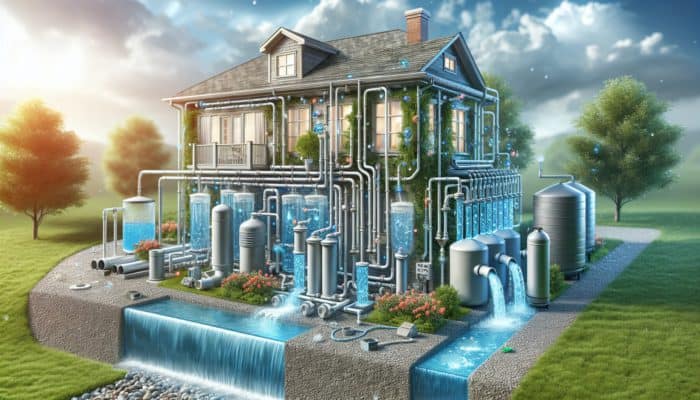Transform Your Water Management Practices with Advanced Rainwater Harvesting Techniques
Discover the Significance of Rainwater Harvesting for Effective Water Conservation and Management

Rainwater harvesting is the practice of systematically collecting and storing rainwater from rooftops and other appropriate surfaces for a wide range of beneficial applications. This eco-friendly technique plays a pivotal role in conserving critical water resources and reducing reliance on traditional water supplies, which is increasingly vital in areas facing water scarcity. By capturing rainwater efficiently, communities can enhance their water supply systems and counteract the detrimental effects of droughts and fluctuating water availability. The rainwater collection process initiates during precipitation, directing the water into a specially designed collection mechanism. This stored water can then be repurposed for an array of uses, including irrigation, drinking, and industrial processes. The global momentum towards adopting rainwater harvesting continues to grow as more individuals recognise its significant role in resource conservation and fostering sustainable living practices.
The rainwater harvesting process starts when rain falls, which is then guided into a dedicated collection system that has been meticulously designed for efficient capture. The collected water can be utilised in numerous applications, including garden irrigation, potable water supply, and various industrial processes. The rising global acceptance of rainwater harvesting systems demonstrates a societal shift towards embracing sustainability and effective resource management, reflecting a collective commitment to environmentally responsible practices.
Uncovering the Extensive Benefits of Embracing Rainwater Harvesting
The advantages of rainwater harvesting extend far beyond the simple conservation of water, encompassing a wide spectrum of economic, environmental, and social benefits. First and foremost, this practice can lead to substantial reductions in water costs, especially in urban regions where the price of municipal water can be excessively high. By employing collected rainwater for non-potable uses, such as landscape irrigation and toilet flushing, both households and businesses can significantly lessen their reliance on municipal water supplies, leading to remarkable financial savings.
Moreover, the environmental sustainability fostered by rainwater harvesting is noteworthy. It plays a vital role in replenishing local groundwater supplies, managing stormwater runoff, and alleviating erosion and flood risks in urban environments. These ecological advantages not only support healthier ecosystems but also boost local biodiversity. Additionally, during drought conditions, having access to a self-sufficient water supply instils a sense of security and strengthens communities against the uncertainties brought about by climate change.
Effective Rainwater Collection Strategies for Varied Environments
There exists a multitude of methods for rainwater harvesting, each offering distinct advantages tailored to specific environmental contexts. The rooftop collection system is among the most common methods, capturing rainwater from building rooftops through gutters and downspouts. This technique is particularly effective in urban settings, where expansive roofs can capture large volumes of rainwater. Alternatively, ground catchments can be employed, utilising wide surface areas to gather water from the ground, making this method more suitable for rural landscapes.
Furthermore, rainwater collection can be efficiently performed on paved surfaces, allowing urban areas to redirect stormwater into storage systems. Each collection method introduces unique considerations, such as cost, maintenance requirements, and compliance with local regulations. An in-depth understanding of these techniques enables the selection of a strategy that aligns with the specific needs and conditions of the location, ensuring optimal efficiency and functionality.
Maximising the Use of Collected Rainwater Across Various Applications

The potential applications of rainwater harvesting are diverse and adaptable, serving various purposes across different settings. In residential areas, harvested rainwater can be used for irrigation, toilet flushing, and laundry, thereby promoting sustainable water usage in everyday activities. In commercial contexts, businesses can implement systems that not only lower water costs but also bolster their sustainability initiatives by using rainwater for landscape maintenance or even for cooling systems in industrial operations.
Agricultural uses of rainwater harvesting are particularly significant in the context of global water management strategies. Farmers can draw upon collected rainwater for crop irrigation, especially in regions prone to drought, thus enhancing crop resilience while reducing dependency on over-exploited groundwater sources. The adaptability of rainwater harvesting underscores its vital role as a sustainable solution to a myriad of water-related challenges confronting society.
Comprehending the Functional Mechanics of Rainwater Harvesting Systems
Key Components of a High-Performing Rainwater Harvesting System
A standard rainwater harvesting system comprises several essential components that work together seamlessly to ensure the effective collection, storage, and utilisation of rainwater. The primary component is the gutter and downspout system, which channels rainwater from rooftops into a designated storage tank. The proper design and strategic placement of these components are critical for maximising water collection while minimising contamination risks.
Following this, the storage tank acts as a reservoir for the collected rainwater, allowing users to access it when necessary. Filtration systems are vital for maintaining water cleanliness and safety, effectively removing debris, leaves, and other pollutants before the water enters the storage tank. Lastly, the distribution network, consisting of pipes and valves, ensures the delivery of harvested rainwater to various applications, such as irrigation or household uses. Each part must be chosen and maintained with care to optimise the overall efficiency and functionality of the system.
A Comprehensive Guide to Installing a Rainwater Harvesting System

The installation of a rainwater harvesting system involves several critical steps that ensure its effectiveness and longevity. The first step is to conduct a thorough site assessment, evaluating factors such as roof area, rainfall patterns, and the intended uses for the collected water. Based on this assessment, suitable components must be selected, including gutters, storage tanks, and filtration systems.
- Carry out a comprehensive site assessment to identify the most effective collection methods.
- Select components that are appropriate for local conditions and specific requirements.
- Install gutters and downspouts to efficiently channel rainwater into collection tanks.
- Establish a filtration system to guarantee water purity before storage.
- Position storage tanks for convenient access and easy maintenance.
- Connect the distribution network to ensure effective utilisation of harvested water.
- Conduct a system test post-installation to identify any leaks or potential issues.
Engaging professional installation services can significantly enhance the system's performance, ensuring that all components function seamlessly and cohesively. After installation, educating users about system maintenance is essential for ensuring maximum efficiency and longevity over time.
Maintaining Your Rainwater Harvesting System: Best Practices for Longevity
Regular maintenance is crucial for preserving the durability and efficiency of rainwater harvesting systems. This includes routine inspections and cleaning of gutters and downspouts to prevent blockages caused by debris, leaves, or sediment. A well-maintained collection system greatly enhances both the quality and quantity of harvested water.
In addition to regular cleaning, inspecting the filtration system is imperative. Filters should be replaced or cleaned frequently to prevent the contamination of stored water. Monitoring storage tanks for any signs of damage or contamination is also vital, with water quality testing recommended to ensure safety for intended applications. Establishing a maintenance schedule and diligently recording activities can aid in the early identification of issues, ensuring the system operates at peak performance.
Expert Insights on Best Practices for Rainwater Harvesting
Guidelines from Professionals for Ensuring High-Quality Harvested Rainwater
To guarantee the safety and usability of harvested rainwater, experts recommend regular water quality testing. This practice is essential for detecting potential contaminants that could pose health risks. Depending on the intended use—whether for irrigation or drinking—specific quality standards must be adhered to.
- Test water for contaminants such as bacteria, heavy metals, and nitrates.
- Implement effective filtration systems to eliminate impurities.
- Consider using UV light or chemical disinfection for potable applications.
- Regularly monitor pH levels to ensure water is suitable for its intended use.
Moreover, maintaining the cleanliness of collection surfaces and storage tanks is paramount. Experts recommend proactive measures, such as installing first-flush diverters, which can significantly improve water quality by redirecting the initial runoff that is often more contaminated. Adhering to these expert recommendations ensures that harvested rainwater remains a safe and valuable resource.
Innovative Technologies Revolutionising Rainwater Harvesting Systems
The field of rainwater harvesting is experiencing significant technological advancements that greatly enhance system efficiency and usability. Innovations such as smart sensors for real-time monitoring are becoming increasingly common. These sensors can measure water levels, assess quality, and even alert users when maintenance is required, optimising both convenience and performance.
Additionally, advanced filtration technologies are emerging, utilising materials like activated carbon or membrane filters to improve the quality of collected rainwater. Integrated storage solutions are being developed to maximise space efficiency, facilitating the seamless integration of rainwater harvesting systems within urban environments. Collectively, these advancements streamline the harvesting process while enhancing user-friendliness and overall effectiveness.
Learning from Successful Rainwater Harvesting Case Studies
Evaluating successful installations of rainwater harvesting systems can provide valuable insights into effective practices and potential challenges. For instance, a residential community in California successfully implemented a rainwater harvesting system, achieving a remarkable reduction in water bills by up to 50%. By utilising rooftops and shared storage tanks, the community exemplifies how collaborative efforts can amplify benefits.
In another noteworthy case, an agricultural project in Australia applied rainwater harvesting techniques to irrigate crops during dry seasons. By capturing and storing rainwater, farmers were able to sustain their yields while reducing reliance on costly groundwater supplies. These case studies underscore the practical advantages of rainwater harvesting, highlighting its potential for water conservation, financial savings, and resilience amidst climate variability.
Evaluating the Environmental Impact of Rainwater Harvesting
Exploring the Environmental Advantages of Rainwater Harvesting
The environmental benefits of rainwater harvesting are extensive and multifaceted. By alleviating the stress on traditional water sources, rainwater harvesting conserves natural ecosystems that often face threats from over-extraction and pollution. Moreover, it reduces stormwater runoff, which can lead to soil erosion, flooding, and the degradation of water quality in local waterways.
When rainwater is effectively captured and utilised, it can significantly relieve the pressure on urban drainage systems, which frequently become overwhelmed during heavy rainfall events. This not only mitigates the risk of flooding but also enhances the quality of water that eventually enters rivers and lakes, thereby benefiting aquatic ecosystems. By promoting sustainable water management practices, rainwater harvesting contributes positively to the overall health of the environment.
Reducing Carbon Emissions Through Effective Rainwater Harvesting Strategies
Implementing rainwater harvesting systems can play a crucial role in diminishing the carbon footprint associated with water usage. Traditional water supply methods, including treatment and distribution, require substantial energy inputs, leading to increased greenhouse gas emissions. By utilising harvested rainwater, individuals and businesses can significantly decrease their reliance on energy-intensive municipal water services.
In regions where energy costs are directly tied to water treatment, particularly in urban settings, integrating rainwater harvesting can yield considerable energy savings. This not only reduces operational costs but also contributes to broader climate change mitigation efforts. As awareness of environmental issues continues to rise, rainwater harvesting emerges as a vital strategy for lowering carbon footprints and advocating for sustainable living practices.
Advancing Sustainable Development Goals Through Rainwater Harvesting Initiatives
Rainwater harvesting plays an instrumental role in advancing global sustainable development goals. Promoting water conservation and responsible resource management aligns with initiatives aimed at ensuring water accessibility and sustainable sanitation for all. This practice not only benefits individual households but also enhances community resilience and sustainability.
Urban areas, in particular, reap significant benefits from rainwater harvesting, as it reduces flooding risks and strengthens water security. Capturing and using rainwater allows cities to improve their infrastructure while alleviating the strain on existing water supply systems. Furthermore, local governments and organisations are increasingly recognising the importance of rainwater harvesting in their development planning, embedding sustainable practices within regional policies.
Enhancing Local Biodiversity Through Rainwater Harvesting Practices
By replenishing groundwater supplies and sustaining soil moisture levels, rainwater harvesting supports habitats conducive to local flora and fauna, thereby fostering biodiversity in both urban and rural contexts. By providing a reliable water source, rainwater harvesting systems can nourish local ecosystems that may struggle during dry spells or drought conditions.
For instance, rainwater harvesting in community gardens can create microhabitats for various species, including birds and beneficial insects. In agricultural settings, utilising harvested rainwater can enhance crop health and resilience, promoting a more biodiverse farming environment. Implementing rainwater harvesting not only aids in conserving water but also plays a significant role in preserving the ecological balance necessary for thriving ecosystems.
Financial Advantages of Implementing Rainwater Harvesting Systems
Realising Significant Cost Savings with Rainwater Harvesting
One of the most compelling financial benefits of rainwater harvesting is the potential for substantial savings on water bills. In many urban areas, where water prices are elevated, using harvested rainwater for non-potable applications, such as irrigation and toilet flushing, can dramatically reduce expenses. Households and businesses alike may notice a significant decrease in their overall financial obligations over time.
Although the initial investment in a rainwater harvesting system may seem considerable, this cost can often be mitigated by the long-term savings it generates. Many users find that their payback period can be as short as three to five years, depending on local water rates and system capacity. Furthermore, as awareness of water scarcity continues to grow, adopting rainwater harvesting may also enhance property values by strengthening sustainability credentials.
Assessing the Return on Investment (ROI) for Rainwater Harvesting Systems
Numerous factors, including local water rates, system size, and intended applications, can influence the return on investment (ROI) for rainwater harvesting systems. In areas where water costs are particularly high, the ROI can be exceptionally attractive, as the direct capture of rainwater results in reduced utility bills.
Moreover, the size of the system is a critical factor in ROI evaluations. Larger systems, which may incur greater initial costs, often yield more significant returns over time, especially in agricultural contexts where consistent irrigation is essential. Many users conclude that the savings generated from harvesting rainwater justify the initial investment, rendering it a financially sound decision in the long run.
Exploring Financial Incentives and Support for Rainwater Harvesting Initiatives
A variety of funding options and incentives are available to encourage the implementation of rainwater harvesting systems. Many governmental and local authorities provide grants, rebates, and tax incentives geared towards making the initial investment more manageable for households and businesses alike. These initiatives aim to promote sustainable water management practices and can significantly alleviate the financial barriers associated with establishing rainwater harvesting.
Moreover, certain non-governmental organisations (NGOs) and environmental groups offer financial aid or low-interest loans to support the installation of rainwater harvesting systems. These funding opportunities broaden access to rainwater harvesting, motivating more individuals and communities to invest in sustainable water solutions that benefit both the environment and their financial situations.
Navigating Challenges in Implementing Rainwater Harvesting
Recognising Common Obstacles in Rainwater Harvesting Systems
While rainwater harvesting presents numerous advantages, several challenges may impede its successful implementation. The initial costs associated with purchasing and installing a rainwater harvesting system can serve as a significant barrier, particularly for low-income households. Additionally, the ongoing maintenance requirements can deter prospective users who may lack the necessary knowledge or resources to manage the system effectively.
Another considerable challenge is ensuring the quality of the harvested water. Without appropriate filtration and regular maintenance, collected rainwater can become contaminated, posing health risks. Users must also be aware of local regulations governing rainwater harvesting, as compliance can sometimes complicate the installation process. Addressing these challenges is crucial for the successful adoption and sustainability of rainwater harvesting systems.
Implementing Solutions to Tackle Rainwater Harvesting Challenges
Innovative solutions are emerging to address the common obstacles associated with rainwater harvesting. Modular systems that are user-friendly and easy to install can significantly reduce initial costs and simplify the installation process. These systems can often be scaled to meet user requirements, making them more accessible to a wider range of households and communities.
Furthermore, advancements in filtration technologies and educational programmes focused on system maintenance can empower users to manage their systems effectively. Community workshops and comprehensive informational resources can provide essential training, ensuring that users are well-equipped to maintain their rainwater harvesting systems. By proactively tackling these challenges, more individuals can embrace the myriad benefits of rainwater harvesting.
Best Practices for Optimising the Efficiency of Rainwater Harvesting Systems
To enhance the performance of rainwater harvesting systems, adherence to best practices is essential. Regular maintenance, including the cleaning of gutters and inspection of tanks, is vital for sustaining both water quality and system longevity. Proper sizing of system components is equally important; systems that are inadequately sized may fail to capture sufficient rainwater, while oversized systems could incur unnecessary costs.
- Establish a consistent maintenance schedule to clean and inspect all components.
- Select the appropriate size and type of tank based on local rainfall patterns and usage requirements.
- Ensure compliance with local regulations and guidelines governing rainwater harvesting.
- Install first-flush diverters to enhance water quality by discarding the initial runoff.
By following these best practices, users will not only improve system performance but also contribute to the sustainability of local water resources. Fostering a culture of responsible water management will ensure the enduring success of rainwater harvesting initiatives.
Frequently Asked Questions About Rainwater Harvesting
What is the primary objective of rainwater harvesting?
The main goal of rainwater harvesting is to collect and store rainwater for subsequent reuse, thereby reducing reliance on conventional water sources while promoting sustainable water management practices.
How can rainwater harvesting lead to financial savings?
Utilising harvested rainwater for non-potable applications can significantly lower water bills, particularly in areas with high municipal water rates.
What are the essential components of a rainwater harvesting system?
Key components include gutters, downspouts, storage tanks, filtration systems, and a distribution network to ensure efficient collection and utilisation of harvested rainwater.
How often should rainwater harvesting systems be maintained?
Maintenance should occur regularly, with checks on gutters, filters, and tanks at least every other year to ensure optimal performance and water quality.
Is harvested rainwater safe for human consumption?
With appropriate filtration and treatment, harvested rainwater can be rendered safe for drinking; however, regular testing is advisable to ensure compliance with safety standards.
What are some common challenges associated with rainwater harvesting?
Common challenges include initial installation costs, ongoing maintenance requirements, and ensuring water quality, all of which must be effectively managed for successful implementation.
Can rainwater harvesting systems be effectively utilised in urban environments?
Yes, rainwater harvesting is especially effective in urban areas, as it leverages rooftops and paved surfaces to capture significant volumes of rainwater.
What innovative technologies are currently used in rainwater harvesting?
Innovations include smart sensors for real-time monitoring and advanced filtration systems designed to enhance the efficiency and usability of harvested rainwater.
How does rainwater harvesting contribute to environmental sustainability?
It alleviates pressure on conventional water resources, minimises stormwater runoff, and aids in preserving local ecosystems, thereby promoting environmental health.
What types of funding options are available for those interested in rainwater harvesting systems?
Many governments provide grants, rebates, and tax incentives to encourage the adoption of rainwater harvesting, making initial investments more affordable.
Join us on our journey on X!
The post Rainwater Harvesting: Sustainable Water Solutions appeared first on Survival Bite.
The Article Rainwater Harvesting for Sustainable Water Solutions Was Found On https://limitsofstrategy.com
The Article Rainwater Harvesting: A Path to Sustainable Water Solutions found first on https://electroquench.com

